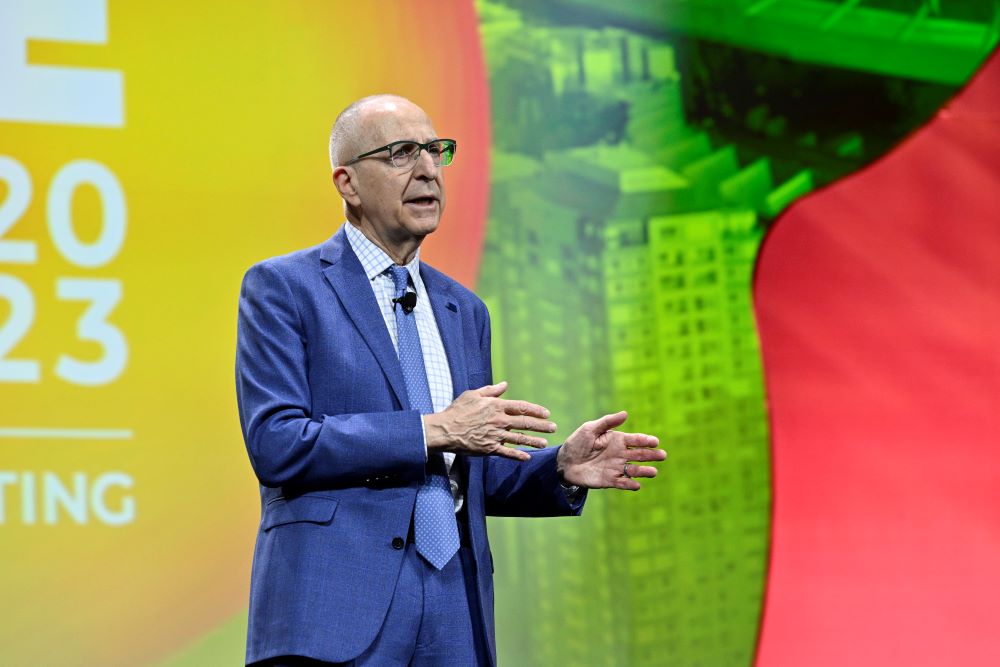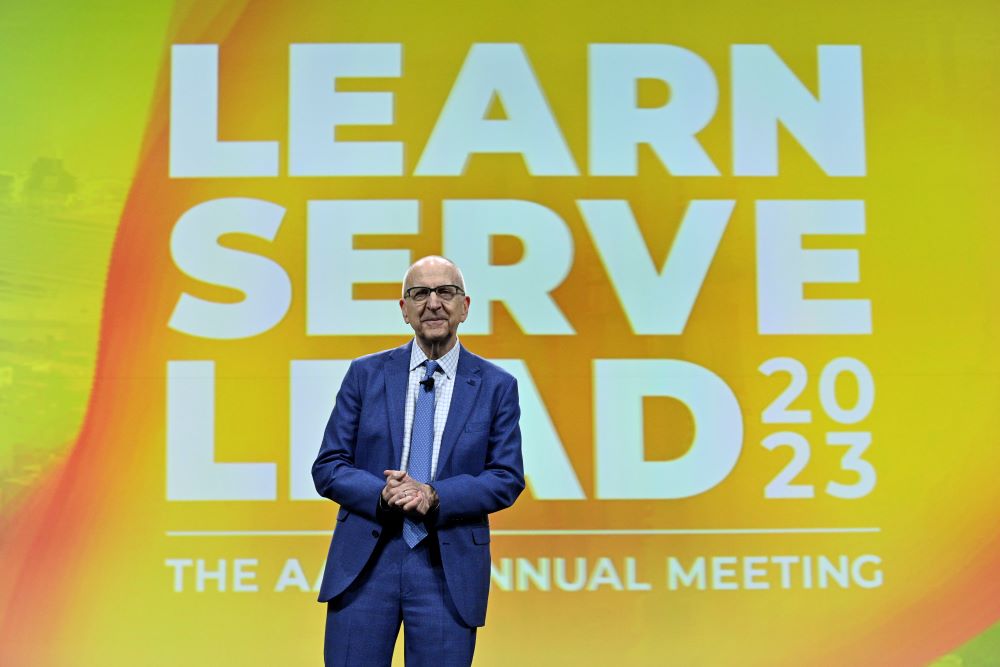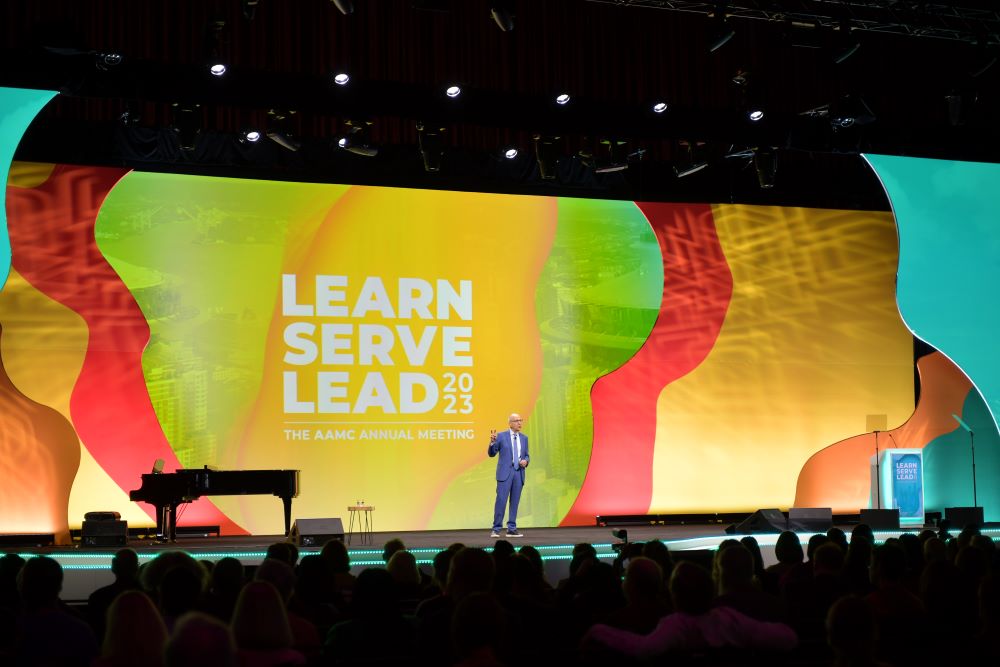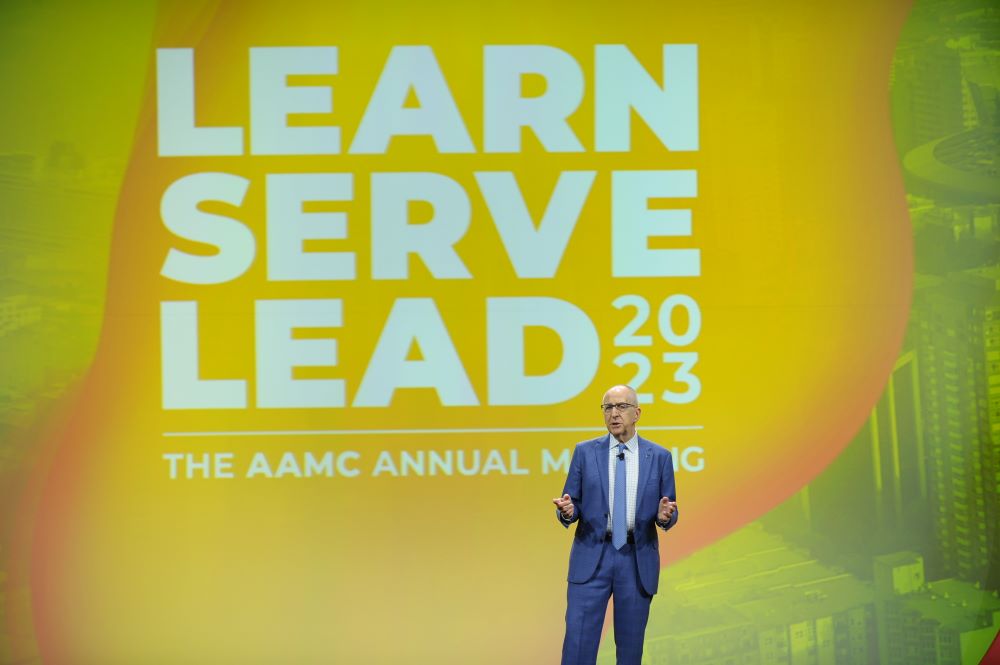His remarks followed a speech by the 2022-23 chair of the AAMC Board of Directors, LouAnn Woodward, MD, entitled “This is Our Why.”
Good morning, everyone! First, I am here to thank you, each and all, for attending this year’s Learn Serve Lead meeting; for caring enough to communicate with the AAMC and with me directly throughout the year; for sharing your constructive suggestions for improvement; for problem solving, for progress, for change; and ultimately, for being invested in this community and in your own local communities.
Second, I want to express my appreciation for your commitment and dedication to improving the health of people everywhere, even when that means rising to face the many obstacles that continue to present themselves to our field.
I want to acknowledge that these times are particularly painful, difficult, and anxiety-producing. That is true in many ways, for many of us: for those who teach and work broadly in medical education; for those who seek to move us toward better and more inclusive health care; for those who deliver that care every day; for those who remind us courageously each day that diversity is our strength, our best chance to improve health; for those who are underrepresented in medicine, yet work tirelessly to make a difference by serving as role models in their own communities; for researchers who strive to understand life in health and disease, and to help us prevent, and diagnose, and treat disease, while comforting our patients and their families; and most important of all, today and every day, for learners who are entering medicine and health care in general at a time of great uncertainty and understandable fear.

Thanks for all you do amid what, in past annual plenary remarks, I have referred to as significant headwinds. To be sure, these headwinds are very real. To be sure, these headwinds are very daunting. We are facing them at the same time that we are already juggling too much, with so little time, and while our health systems are battling serious financial pressures and labor shortages.
All of these pressures on all of us take their toll on our well-being and mental health. We must take that seriously. But I truly believe that we, as a broad community of academic medicine, have the stamina, resources, and creativity to overcome even our most troublesome problems. We can succeed if we walk this path together.
We, as a broad community of academic medicine, have the stamina, resources, and creativity to overcome even our most troublesome problems. We can succeed if we walk this path together.
One particular challenge that is top of mind for me and deserves serious attention is the opposition we face to the concepts of diversity, equity, and inclusion. This is not just opposition to specific initiatives. No, this is opposition to the very ideas themselves. I continue to believe in the fundamental importance of this work. And we at the AAMC will never surrender or reverse course on our drive toward a more diverse, inclusive, and equitable profession.
We do this and we take this stand not based on politics, not based on ideology, but based on accumulating data. No matter the pressures or political obstacles, particularly in an election year, we must keep evidence at the core. For there is significant evidence that more diverse health care teams improve trust, communication, and patient satisfaction, and growing evidence that diverse teams improve health care outcomes and can save lives. And that is our goal.
We take this stand not based on politics, not based on ideology, but based on accumulating data. ... More diverse health care teams improve trust, communication, and patient satisfaction.
The evidence continues to mount that more diverse student bodies improve education and that more diverse teams — including health care and research teams — solve more complex problems better and are more effective.
Of course, I recognize the real hurdles that some of your institutions are up against, particularly in jurisdictions where pressures to end formal DEI efforts are clear and even legislated — but we must push forward nonetheless.
My colleagues and I have heard your feedback on the adversity you face at some of your institutions. Now, based in part on that feedback, based in part on our strategic plan, and based in part on evolving research, we are concentrating on at least three areas.
First, we will work with you to smooth the path for learners, removing as many obstacles as possible. We are working to fill the pathway of medical school applicants by inspiring students even earlier to consider a career in medicine — as early as, say, middle school.
The AAMC recently committed a major investment toward expanding the Summer Health Professions Education Program, the largest and most successful prehealth academic program in the country. The AAMC will expand this program this year with two new collaborations: one at a tribal college or university, and one at a Historically Black College or University.
And last July, the AAMC organized a first-of-its-kind summit with attendees from K-12 school districts, White House appointees, national education associations, medical schools, and teaching hospitals across the nation. There, we forged relationships that will help us make a greater impact at the K-12 level.
Yet, and second, our outreach and recruitment efforts alone are not enough. To succeed, we need to ensure that the climates and cultures at our institutions support diverse people and diverse perspectives. Our learning environments need to enable everyone to not only survive, but to thrive. And another strategic direction is to create these equitable and inclusive environments.
Our learning environments need to enable everyone to not only survive, but to thrive.
I’m so impressed that more than 100 medical schools have participated in the DICE Inventory. That’s a tool that is helping them to actively understand and improve the diversity, inclusion, culture, and equity within their institutions — that’s where the acronym “DICE” comes from. This is a major step forward.
And third, you have asked for more resources related to DEI. I’m grateful that many of you participated in our webinar in July on the impact of the Supreme Court’s decisions on race-conscious admissions. Many of you also tuned into the AAMC’s “Beyond the White Coat” podcast and consulted the many resources on our website on this particular topic.
Part of this third area of concentration is to compile and share more evidence-based communications. We need to pursue more research and to more broadly increase understanding of the proven value of diversity in medical education, research, and health care. For sharing even more convincing data will help us make headway.
We will work with you to smooth the path for learners ... We need to ensure that the climates and cultures at our institutions support diverse people and diverse perspectives. ... [and] we need to pursue more research and to more broadly increase understanding of the proven value of diversity.
One study you are very likely aware of that was published just this last April in JAMA Network Open presented a stark reality — just one study: When there are more Black primary care doctors in a county, the Black people there actually live longer. It’s hard to ignore the strength and importance of that research finding.
We cannot and we will not walk away from our commitment to diversity, equity, and inclusion. Let’s walk this path together.
In addition to the critical importance of diversity, other areas call for our urgent attention, including climate change, artificial intelligence, and disagreements about the place and the limits of free speech amid rampant disinformation — among so many other issues.

But tempting as it can be to feel discouraged about the path ahead and these discrete challenges — and believe me, I’m not immune to that feeling from time to time — I’m here today to share, overall, I believe there’s great cause for hope.
Much of the optimism that stubbornly keeps rising to the top for me comes directly from you. Just look around you for just a moment. This room is a treasure trove of local, and national, and international perspectives. I see and feel your wisdom. I see and feel your passion. And I see and feel your determination, as well as the strengths of the institutions.
Together we are part of a vast ecosystem, and when that ecosystem works together toward common goals, I believe we can make a real difference for our learners, our faculty, our patients, their families, and our community. In fact, we’ve proven this before.
“From the shadows of healthcare, we rise,” writes Jason Stalling, who was pursuing a Doctor of Sciences degree from Eastern Virginia Medical School in 2021, just completed this past May. Those were the first words of a poem he shared with the AAMC two years ago amid the pandemic. The poem continues:
Now on
the front stage.
Science and planning on a
moment’s notice have
collided…
With a hidden enemy at our
door, lives are lost in a battle
of time.
Steadfast and determined,
we will not fail.
The title of his poem? “Invisible Enemy.”
What a positive way to view such a horrific time. We in health care were united against a common enemy — in this case, a virus. We did not give up, even when the evidence-based recommendations of scientists were publicly questioned. We forged on, dependent on each other, sharing newly improvised treatment and education protocols with each other, all for the public good, stepping in to help even if it meant stepping outside our typical roles, united in solidarity with each other.
Throughout my more than 40 years in academic medicine, I’ve seen our community come together like this in remarkable ways, from HIV/AIDS to novel approaches to cancer and beyond. There are so many. COVID just happens to be the most recent example, where all of academic medicine united, and where solutions felt nearly impossible at the time, but together we were unstoppable. We persevered.
None of us can solve all the problems facing the health care profession alone. That’s obvious. That’s why the theme of my comments today is “Let’s Walk This Path Together.”
Each of us has a role to play within this interdependent ecosystem — and that includes the AAMC itself. We are the only association that is of the academic medicine community and for the academic medicine community. The breadth and depth of our programs, advocacy, services, strategic plan, affinity groups, councils, conferences, learning opportunities, and virtual communities are all part of this ecosystem. And there are many more.
And so, at the association level, we are committed to learning and growing from the valuable feedback and insights you share about how we can best support you and lead where we all need to go. Today I thank everyone who has brought to me or my colleagues a concern or a question about how we’re approaching our complex work, and I encourage you, please, continue to raise those questions. I take this feedback to heart. I take this feedback deeply and personally.
Thanks to you and your colleagues, we at the AAMC have received helpful and important feedback about our services, about our policies, what we stand for, and ultimately who we are fundamentally as an organization. And I want to address directly three items you have shared with me and my colleagues.
One, I recognize some of you have the perception that the AAMC is a progressive, left-leaning organization. I understand where this perception originates, because many of our statements and many of my own interviews and positions seem to align with the left. But I would characterize our position as being not left, not right, but squarely focused on what will benefit the health of people everywhere. That is our mission.
Across the vast ecosystem of academic medicine, it’s not surprising that we can disagree on any specific policy, but we share a foundation and core values that unite us. And we have much we can learn from each other if we truly listen.
For my part, I pledge today to actively listen to you, and to make myself and the AAMC more available to listen, to interact, and to brainstorm with you. Even — and I would say especially — in cases where there are differences of opinion on matters of policy and the way forward.
We have already started down this path of holding space for divergent views. That is why again this year, we started this annual meeting yesterday with an opening plenary that touched on the topics of free speech and differences of opinion and how to attempt to navigate this issue. This year’s opening plenary with Amna Khalid, Jacob Mchangama, and Michael Roth was the latest along that path.
In my view, the historical record shows pretty clearly that — in almost all situations – the more free speech, the better. My hope is that as we learn to listen more, we’ll rediscover the core values that we all have in common, despite our differences. Those values — and our mission to achieve better health for people everywhere — are ultimately why we’re all here.
My hope is that as we learn to listen more, we’ll rediscover the core values that we all have in common, despite our differences. Those values — and our mission to achieve better health for people everywhere — are ultimately why we’re all here.
The second area of feedback you’ve shared over the years — some of you have felt the AAMC has been slow to innovate our products and services. I understand this concern as well. Our services for you could absolutely always be improved.
In part as a result of this perception, over recent years, some specialties have decided, for example, to develop or use their own residency application systems. What should the AAMC’s response to these new application systems be? What we aim to do and what we need to do is to earn again — every day, through every application and every service — to earn again your confidence and respect.
In the process, we hope you’ll share our excitement about new developments we have co-created together with you over the past few years.
In recent years, in my view, the pace of innovation of our services has actually increased enormously. And yet we have not, and I have not, done an adequate job of sharing this progress. And obviously there is so much farther to go. I pledge today to communicate more effectively with you about these and upcoming future changes.
The pace of innovation of our services has actually increased enormously ... I pledge today to communicate more effectively with you about these and upcoming future changes.
Of course, the difficulties of the current transition-to-residency process are well known and significant. There is a real need to improve the data, processes, and approaches to reducing the enormous pressures of the current system, which is why the AAMC continues to be an active member of the Coalition for Physician Accountability. A subgroup of this coalition has laid out 34 recommendations for improvement, and we are involved, with many other organizations, in bringing many of these recommendations to life, as well as implementing new and cutting-edge technology.
Of many examples I could cite from the recommendations around optimization of the application and interview processes is our recent collaboration with Thalamus, which is recognized as the premier, cloud-based interview management platform, specifically designed for applications to GME training programs.
Our collaboration with this agile organization shows our even more focused intention to innovate in the interest of learners and program directors. And collaborating with the community, including 40 people from different specialties and from schools, we are making significant step-by-step improvements in interview management and application review. This work is helping program directors manage their huge applicant pools more effectively, while also streamlining the process for those applying for residency positions. But we have more work ahead.
Overall, having differing specialties go their own way for the residency application process is deeply concerning because it will fragment the experience and the processes for learners. It will also compromise our ability to provide comprehensive data on a variety of matters critical to improving the transition to residency. And our decades-long continuum of data that the AAMC gathers on behalf of the full academic medicine community is what gives us the broadest perspective to recognize, and therefore be able to solve, our community’s thorniest problems.

We need to keep innovating. We need to involve learners, program directors, advisors, and faculty even more directly in that process, and to keep you all much better informed.
Third, I’m aware of the perception of the AAMC as being focused on revenue. Now, for those who do not have the visibility into the big picture of who we are as a mission-focused nonprofit, including all of the programs and services we continuously invest in, I can surely see how this perception developed.
The overall educational financial pressures on learners have grown tremendously over the last decades. Many of the efforts by our Services team at the AAMC have been oriented toward reducing application numbers, including sharing of data and analytics to improve that transparency.
Yet I’m very pleased to see a recent, positive trend. Preliminary data collected following the ERAS® September program opening just a couple of months ago show a noticeable decrease in the overall average number of applications per resident applicant. This is good news! It’s the first time in more than a decade that this number has dropped. We’ll see, together, to monitor this, if the initial trend continues.
The AAMC is working very hard to mitigate the financial burden on learners. And I want to share two announcements. In the next 90 days, we will introduce a fundamental change in our ERAS fee structure based on the input of learners and the student affairs community. That’s number one.
And number two: Yesterday at this meeting, we introduced a major financial assistance program for ERAS, based in part on our longstanding Fee Assistance Program for MSAR®, AMCAS®, and the MCAT® system. That is starting with the very next cycle. But there is so much more to do.
Yesterday at this meeting, we introduced a major financial assistance program for ERAS, based in part on our longstanding Fee Assistance Program for MSAR®, AMCAS®, and the MCAT® system. That is starting with the very next cycle.
Let’s walk this path together.
It is our coming together like this — not only here in Seattle at this annual meeting but, more importantly, every day in every corner of academic medicine — that gives me hope for the way forward, in spite of the many headwinds I outlined at the beginning of my talk.
I am encouraged, for example, by new and exciting approaches to competency-based education, supported by data. I am inspired by the work of nearly 1,400 people, just over half of them from your own institutions, who are joining with the AAMC Center for Health Justice and its collaborative for health equity called CHARGE, as well as its Multisector Partner Group of experts representing all sectors of the health ecosystem, to collaboratively improve population health and achieve health equity across the country at last.
I appreciate the collaboration I’ve seen after the Alliance of Academic Health Centers and the Alliance of Academic Health Centers International merged with the AAMC just last year, expanding our reach and collective potential for impact around the world.
I am encouraged by the AAMC’s powerful advocacy program, fighting skillfully for everything academic medicine requires to continue to serve learners and educators, clinicians, researchers and all people and the health of communities in the most effective ways.
And I am excited about a major organizational change that will now more directly and effectively serve the leaders of our academic health systems by bringing together the new Council of Academic Health System Executives.
These are all exciting changes, developed only with your input and guidance. I remind myself about that on days and in circumstances where I fear the hurdles ahead are just too much to overcome. We are up to the challenge. Let’s walk this path together.
Do you remember when people would ring bells at their doorsteps to celebrate health care workers in 2020? Our patients, their families, and our communities were in awe of the work that you did, of the sacrifices health care workers made to help those who needed our help the most.
Well, there may be fewer bells ringing today, but you are still those heroes!
We have what it takes to overcome whatever lies ahead of us: our collective power and strength. Let's do this.
I am in awe of everything you do. I’m in awe of everything you accomplish, together for everyone’s health. You’ve worked hard, and in these past few years harder than ever, with grit and with determination, with adaptability and with creativity. You’ve invested so much to get us where we are.
And if I asked each of you today, “Why are you here? Why did you choose this field, this role, this moment in time to do what you’re doing?” I imagine many of you might say something like, “This is my passion. It’s a calling, it’s not just a job.”
I feel that same passion myself. It’s why I entered the field of medicine, which I consider one of the most rewarding careers there is. And we — all of us, regardless of our role — we rise to the occasion. We help, in whatever way we can, even when it seems almost impossible. That’s what we do.

I have every confidence we’ll do that again and again. As many times as we need, and regardless of which roadblocks appear, or how impossible the task. This is what we do.
Together, we will team up with each other and with our communities to diversify the workforce. Together, we will navigate new technologies like AI in a way that supports health equity, rather than worsening inequities. Together, we will address climate change through the lens of health to promote environmental justice. And so much more.
We will rise to the occasion. No one of us, no matter how well equipped, can solve these complex challenges alone. Thankfully we don’t have to. We have each other. We have what it takes to overcome whatever lies ahead of us: our collective power and strength.
Let’s do this. Let’s walk this path together. Thank you.